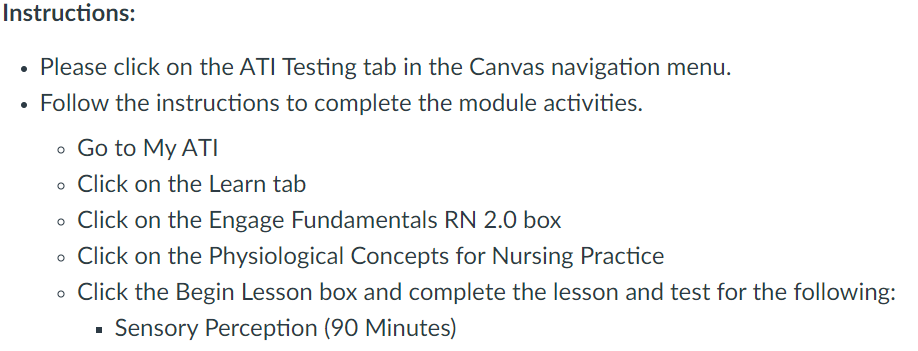 NUR109 M8.2: ATI Engage Fundamentals: Sensory Perception
NUR109 M8.2: ATI Engage Fundamentals: Sensory Perception
A nurse is assessing a client whose family is concerned that the client has developed dementia. Which of the following findings should the nurse identify as a manifestation of dementia?
Rapid-onset memory loss
Hyperglycemia
Hypervigilance
Difficulty problem-solving
Answer: Difficulty problem-solving.
Explanation: Difficulty with problem-solving is an expected manifestation of dementia. Dementia is non-reversible, but the nurse can help the family develop strategies to manage the client’s condition.NUR109 M8.2: ATI
A charge nurse is discussing sensory processing disorder (SPD) with a newly licensed nurse. Which of the following statements should the charge nurse make?
“SPD occurs when a client’s brain is unable to process rapidly occurring multiple stimuli.”
“SPD causes clients to be overly sensitive to stimuli, such as the feel of fabric on their skin.”
“A client is diagnosed with SPD if they experience a significant decrease in stimuli.”
“A client who has SPD has a deficit in the function of one or more of their five senses.”
Answer: “SPD causes clients to be overly sensitive to stimuli, such as the feel of fabric on their skin.”
Explanation: SPD is a sensory disorder in which a client experiences a hypersensitive response to normal stimuli, such as the sound of a television or the feel of fabric on their skin.
A nurse is caring for a client who has hearing loss. Which of the following actions should the nurse use to enhance communication with the client? (Select all that apply.)NUR109 M8.2: ATI
Provide the client with large print materials.
Ensure the client wears their hearing aids.
Use a sign language interpreter.
Communicate using paper and pen.
Face the client when speaking.
Answer:
Ensure the client wears their hearing aids.
Use a sign language interpreter.
Communicate using paper and pen.
Face the client when speaking.
Explanation: When caring for a client with hearing loss, it is important to ensure they have their hearing aids, use a sign language interpreter when necessary, communicate in writing when appropriate, and face the client when speaking to maximize their ability to understand and interact effectively.
A nurse is reviewing the medical history of a client who has conductive hearing loss. The nurse should identify which of the following factors as a potential cause of conductive hearing loss? (Select all that apply.)
Trauma to the outer ear
Damage to inner ear structures
Inflammation
Down syndrome
Cerumen buildup
Otitis media
Answer:
Trauma to the outer ear
Inflammation
Cerumen buildup
Otitis media
Explanation: Conductive hearing loss can result from factors like trauma to the outer ear, inflammation, cerumen (earwax) buildup, and conditions such as otitis media (ear infections).NUR109 M8.2: ATI
A nurse is caring for an older adult client who reports unintended weight loss. The client reports that their food does not taste right. The nurse should inform the client that the ability to taste which of the following decreases with age? (Select all that apply.)NUR109 M8.2: ATI
Sweet
Sour
Spicy
Bitter
Salty
Savory
Answer:
Sour
Bitter
Salty
Explanation: The ability to taste sour, bitter, and salty flavors may decrease with age, affecting the perception of these tastes.NUR109 M8.2: ATI
A nurse is preparing a poster presentation about sensory alterations. Which of the following information should the nurse include about sensory deprivation?NUR109 M8.2: ATI
Sensory deprivation is commonly experienced by clients who are in the ICU.
Sensory deprivation can cause tactile stimuli to feel painful.
Risk factors for sensory deprivation include experiencing total vision or hearing loss.
Sensory deprivation occurs most often in children who have developmental disorders.
Answer: Risk factors for sensory deprivation include experiencing total vision or hearing loss.
Explanation: Sensory deprivation can result from a lack of sensory stimulation, and it is more likely to occur in individuals who have experienced total vision or hearing loss, among other risk factors.
A nurse is caring for a middle-adult client who asks about expected age-related changes. Which of the following sensory changes should the nurse include as age-related change?
Presbyopia
Diplopia
Myopia
Astigmatism
Answer: Presbyopia.
Explanation: Presbyopia is an age-related change characterized by a decrease in the ability to focus clearly on objects that are up close, which typically begins during middle adulthood due to a loss of flexibility of the lens of the eye.
A nurse is preparing to administer medications to a client. Which of the following classifications of medications should the nurse identify as being ototoxic? (Select all that apply.)
Loop diuretics
Benzodiazepines
NSAIDs
Antihistamines
Aminoglycoside antibiotics
Answer:
Loop diuretics
NSAIDs
Aminoglycoside antibiotics
Explanation: Medications classified as ototoxic, meaning they can cause damage to the ear and hearing, include loop diuretics, NSAIDs, and aminoglycoside antibiotics.
For those seeking assistance with ATI testing or online tutoring for nursing, I encourage you to consider our services at fixmygpa.com. Our team of experts is well-versed in nursing concepts, including sensory perception, and can provide the support you need to excel in your nursing education. Whether you require guidance on ATI exams, assignments, or understanding fundamental nursing principles, we are here to help you succeed. Don’t hesitate to reach out and take the next step toward achieving your academic goals.


